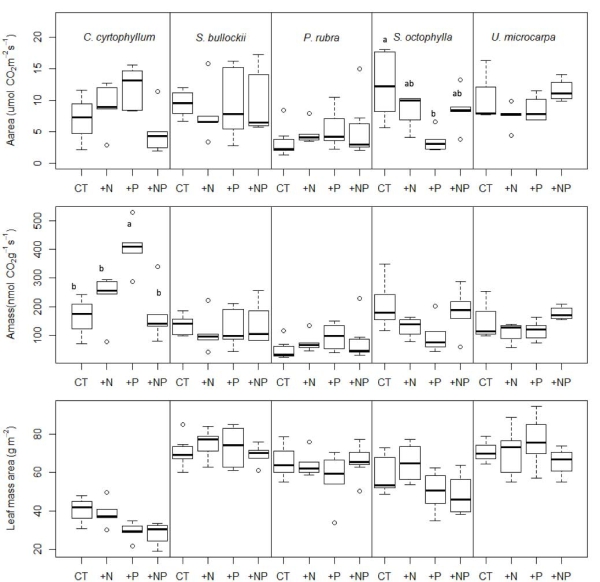

Tropical forests have some of the largest trees and fastest plant growth on Earth, even though they are often found on infertile soils. Tropical soils generally have low availability of phosphorus (P), one of the nutrients essential for photosynthesis, which maintains plant growth. As a result, tropical forest growth is generally thought to be limited by the availability of P to plants. Recent research shows that some plants can grow very well on infertile soils because they can use P efficiently. However, we do not know how these plants are able to maintain high rates of photosynthesis and growth when P-availability is low.
To find out how plants are able to thrive on low-P soils, researchers leading by Dr. WANG Faming and Prof. LI Zhian from South China Botanical Garden of Chinese Academy of Sciences tested how changes in nutrient availability affected the plants’ ability to maintain photosynthesis by applying different fertilizers to experimental plots, and analyzed the amount and type of P in plant leaves.
By isolating different compounds containing P in leaves, we found that most of the plants were able to redistribute P to different functions and structures, which helped maintain their ability to capture sunlight when P availability was low. In the soils with low P, plants reduced the amount of P allocated to leaf structure and leaf growth, and instead invested it in compounds used in photosynthesis. The study demonstrates that tropical forest plants may have adapted to low P-availability by strategically investing P in photosynthesis, and this could explain how many tropical forests can thrive on low-P soils.
This study is published on line in Functional Ecology, titled with “Foliar phosphorus fractions reveal how tropical plants maintain photosynthetic rates despite low soil phosphorus availability”.
Michigan State University Distinguished Professor, Dr. Thomas D. Sharkey, who is a senior expert in photosynthesis and was not included in this study, commented that this study is “Excellent proof that photosynthesis is the last thing to suffer in limited P nutrition. The triose phosphate use limitation is not caused by P nutrition.”
For details, please refer to: https://besjournals.onlinelibrary.wiley.com/doi/10.1111/1365-2435.13252.

Figure. Box‐plots of area‐based and mass‐based photosynthetic rates (Aarea and Amass) and leaf mass per unit area (LMA) for five woody species in a tropical forest following 6 years of fertilization with nitrogen (+N), phosphorus (+P) or both nutrients (+NP) compared to controls (CT). Different letters within panels indicate post‐hoc significant differences 20 among treatments at p < 0.05

